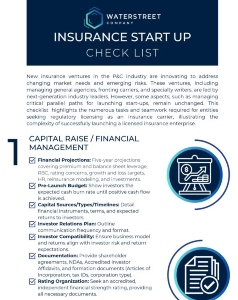New insurance ventures are entering the P&C industry in stunning ways. The insurance industry today must address changing market needs and to transfer some, or all, of emerging risks.
Whether these startups are managing general agencies, fronting carriers, excess and surplus lines carriers, specialty writers, captives, or risk retention groups, they are tackling new challenges in the P&C industry. Next-generation industry leaders are innovating their way to solutions.
In this series, we have identified certain parallel paths under which the tasks of creating an insurance startup may fall as they are simultaneously worked upon. Each article in our series will cover the following critical paths:
- Capital Raise and Financial Management
- Regulatory Approval Process
- Operational Preparedness and Technology Choices
- Business Model, Plan and Product Model
- Competitive Environment
Our series is meant to help insurance startups on their path to success with step-by-step guidance.
Raising Capital & Financials
1. Five Year Financial Projections
When creating a P&C insurance startup, five-year financial projections are crucial to secure investor confidence and navigate the complexities of the industry.
These projections need to address premium and balance sheet leverage, which is critical for assessing the company’s ability to meet policyholder obligations while maintaining profitability. Managing leverage effectively requires a delicate balance between growth and financial stability. The use of industry-specific financial ratios, such as the loss ratio and expense ratio, can provide clarity.
Risk-Based Capital (RBC) is another essential element, as it measures the minimum capital required to support a company’s operations given its risk profile. Startups must ensure their projections demonstrate adequate RBC levels to meet regulatory requirements and avoid potential solvency issues. Rating agencies will scrutinize these projections to assess the startup’s financial health, so it’s vital to include robust scenarios that account for potential rating concerns.
Growth and loss experience targets must be realistic yet ambitious. Overly optimistic targets can undermine credibility, while conservative estimates may not attract sufficient investment. Use historical data, market research, and advanced actuarial models to set these targets accurately. Human resources also play a pivotal role as projections should outline the costs associated with building a capable team and maintaining operational efficiency.
Reinsurance is a critical aspect of the business model for any P&C startup. Realistic reinsurance modeling, which includes the cost and availability of reinsurance coverage, is necessary to manage risk exposure and protect against catastrophic losses.
At the close of the exercise, investment considerations should reflect the following:
- Risk tolerance
- Liquidity needs
- Long-term growth objectives
Diversify the investment portfolio while aligning it with the company’s overall strategy to help sustain financial health. By addressing these components thoroughly, the five-year financial projections can serve as a powerful tool to guide the startup’s early years and attract the necessary capital.
2. Pre-Launch Budget
A pre-launch budget is essential for demonstrating to investors how the startup plans to manage its cash flow before reaching profitability.
This budget should clearly outline the anticipated cash burn rate, which represents the amount of capital the company will need to cover expenses during the pre-revenue phase. Key areas to include are:
- Product development
- Regulatory compliance
- Marketing
- Staffing
- All operational costs to get the business off the ground
Investors will scrutinize this budget to ensure that the company has a realistic timeline and sufficient funding to sustain operations until cash flows turn positive. By detailing the timing of expenses and the expected milestones, the budget helps in building investor confidence. It should include contingency plans for potential delays or cost overruns, showing a proactive approach to financial management and increasing the likelihood of securing the necessary capital.
3. Capital Source, Types and Timelines
When seeking investment for a P&C insurance startup, it is essential to clearly define the capital sources, types, and timelines.
Investors need to understand the specific financial instruments being offered, such as equity, debt, or convertible notes, and the terms associated with each. These details provide transparency on how their investment will be structured, including the potential returns and risks involved.
The timeline for capital deployment and expected milestones is equally important, as it helps investors gauge the startup’s progress and when they can anticipate returns. Providing a well-structured plan should outline:
- The stages of funding
- The use of proceeds
- The projected exit strategy
These details increase investor confidence. It also ensures alignment between the startup’s financial goals and investor expectations. Without this clarity, securing the necessary capital becomes challenging, as investors are unlikely to commit without a comprehensive understanding of their potential investment’s structure and returns.
4. Investor Relations Plan
An effective Investor Relations Plan is crucial to maintain strong relationships with investors and ensure their ongoing support.
Clear and consistent communication helps investors stay informed about the startup’s progress, financial health, and any challenges that may arise. This plan should detail the frequency and form of communication, such as:
- Routine updates
- Quarterly reports
- Annual meetings
Beyond just communication, it’s essential to ensure that the business model aligns with investors’ expectations regarding risk and return. This means transparently discussing:
- Potential risks
- Outlining how the company plans to mitigate them
- Setting realistic expectations for returns
By aligning the company’s goals with investor expectations, the plan fosters trust and encourages a collaborative approach to overcoming obstacles. A well-crafted Investor Relations Plan not only keeps investors engaged but also reinforces their confidence in the startup’s ability to achieve its objectives, making them more likely to continue their support in the long term.
5. Shareholder Agreements
It is vital to provide comprehensive and well-prepared documentation when launching a P&C insurance startup, as it ensures transparency and legal compliance. The following documents are foundational and must be made available to investors and regulators:
- Shareholder agreements
- Debt instruments like surplus notes
- Non-Disclosure Agreements (NDAs)
- Accredited Investor Affidavits
These documents clearly define the rights, responsibilities, and obligations of all parties involved, helping to prevent disputes and ensure that all transactions are legally sound.
Official formation documents and filings are also critical. These include the Articles of Incorporation, which establish the company’s legal existence, and filings for federal and state tax identification numbers, which are necessary for tax reporting and compliance. The type of corporation—whether stock, mutual, or reciprocal—should also be clearly outlined, along with the rationale for selecting that structure. Each corporate form has distinct implications for ownership, governance, and financial management, and it’s important that investors understand why a particular structure was chosen.
These well-organized and readily available documents not only instill confidence in investors and regulators but also positions the startup for smooth operations and potential future audits. This thorough documentation ensures that the startup adheres to all legal requirements, paving the way for successful fundraising and sustainable growth.
6. Seek Rating Organization
Securing an accredited, independent financial strength rating from a recognized rating organization is a crucial step for any P&C insurance startup. A strong rating serves as an endorsement of the company’s financial stability and ability to meet its obligations to policyholders, which is essential for building trust with investors, regulators, and customers.
To obtain this rating, the startup must provide comprehensive documentation that covers nearly every aspect of its operations. This includes:
- Five-year financial projections
- Pre-launch budget
- Capital sources
- All legal and regulatory filings
Rating organizations will meticulously evaluate the company’s financial health, including its capitalization, risk management practices, reinsurance arrangements, and investment strategy. They will also scrutinize the governance structure, shareholder agreements, and the alignment of the business model with long-term financial goals.
A well-prepared submission that addresses all these areas not only facilitates the rating process but also enhances the company’s credibility in the market.
WaterStreet Company & Insurance Startups
Here at WaterStreet Company, we support P&C insurance startups with next-generation, cloud-based insurance software. From Policy Administration and Underwriting to Claims and Accounting, we provide all elements of technology for your company to thrive.
Experience firsthand how WaterStreet’s cloud-based solutions can revolutionize your P&C insurance operations. Contact us today to request a consultation and demo.
Authored by Kelly King, CFO of WaterStreet Company





